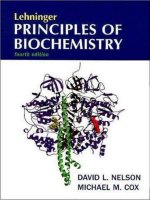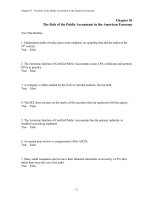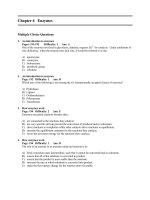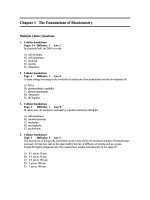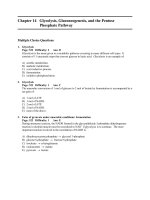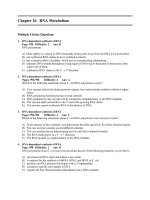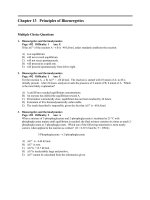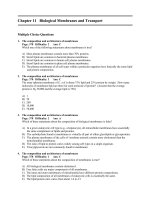lehninger principles of biochemistry test bank ch 6pdf (1)
Bạn đang xem bản rút gọn của tài liệu. Xem và tải ngay bản đầy đủ của tài liệu tại đây (255.84 KB, 20 trang )
Chapter 6 Enzymes
Multiple Choice Questions
1. An introduction to enzymes
Pages: 191-192
Difficulty: 1 Ans: A
One of the enzymes involved in glycolysis, aldolase, requires Zn2+ for catalysis. Under conditions of
zinc deficiency, when the enzyme may lack zinc, it would be referred to as the:
A)
B)
C)
D)
E)
apoenzyme.
coenzyme.
holoenzyme.
prosthetic group.
substrate.
2. An introduction to enzymes
Page: 192 Difficulty: 1 Ans: D
Which one of the following is not among the six internationally accepted classes of enzymes?
A)
B)
C)
D)
E)
Hydrolases
Ligases
Oxidoreductases
Polymerases
Transferases
3. How enzymes work
Page: 194 Difficulty: 2 Ans: E
Enzymes are potent catalysts because they:
A)
B)
C)
D)
E)
are consumed in the reactions they catalyze.
are very specific and can prevent the conversion of products back to substrates.
drive reactions to completion while other catalysts drive reactions to equilibrium.
increase the equilibrium constants for the reactions they catalyze.
lower the activation energy for the reactions they catalyze.
4. How enzymes work
Page: 194 Difficulty: 1 Ans: D
The role of an enzyme in an enzyme-catalyzed reaction is to:
A)
B)
C)
D)
E)
bind a transition state intermediate, such that it cannot be converted back to substrate.
ensure that all of the substrate is converted to product.
ensure that the product is more stable than the substrate.
increase the rate at which substrate is converted into product.
make the free-energy change for the reaction more favorable.
Chapter 6 Enzymes
5. How enzymes work
Pages: 194-196
Difficulty: 2 Ans:D
Which one of the following statements is true of enzyme catalysts?
A)
B)
C)
D)
E)
Their catalytic activity is independent of pH.
They are generally equally active on D and L isomers of a given substrate.
They can increase the equilibrium constant for a given reaction by a thousand fold or more.
They can increase the reaction rate for a given reaction by a thousand fold or more.
To be effective, they must be present at the same concentration as their substrate.
6. How enzymes work
Pages: 194-196
Difficulty: 2 Ans: D
Which one of the following statements is true of enzyme catalysts?
A) They bind to substrates, but are never covalently attached to substrate or product.
B) They increase the equilibrium constant for a reaction, thus favoring product formation.
C) They increase the stability of the product of a desired reaction by allowing ionizations,
resonance, and isomerizations not normally available to substrates.
D) They lower the activation energy for the conversion of substrate to product.
E) To be effective they must be present at the same concentration as their substrates.
7. How enzymes work
Pages: 195-196
Difficulty: 1 Ans: C
Which of the following statements is false?
A)
B)
C)
D)
E)
A reaction may not occur at a detectable rate even though it has a favorable equilibrium.
After a reaction, the enzyme involved becomes available to catalyze the reaction again.
For S → P, a catalyst shifts the reaction equilibrium to the right.
Lowering the temperature of a reaction will lower the reaction rate.
Substrate binds to an enzyme's active site.
8. How enzymes work
Page: 197 Difficulty: 1 Ans: B
Enzymes differ from other catalysts in that only enzymes:
A)
B)
C)
D)
E)
are not consumed in the reaction.
display specificity toward a single reactant.
fail to influence the equilibrium point of the reaction.
form an activated complex with the reactants.
lower the activation energy of the reaction catalyzed.
61
62
Chapter 6 Enzymes
9. How enzymes work
Page: 198 Difficulty: 2 Ans: A
Compare the two reaction coordinate diagrams below and select the answer that correctly describes
their relationship. In each case, the single intermediate is the ES complex.
A) (a) describes a strict “lock and key” model, whereas (b) describes a transition-state
complementarity model.
B) The activation energy for the catalyzed reaction is #5 in (a) and is #7 in (b).
C) The activation energy for the uncatalyzed reaction is given by #5 + #6 in (a) and by #7 + #4
in (b).
D) The contribution of binding energy is given by #5 in (a) and by #7 in (b).
E) The ES complex is given by #2 in (a) and #3 in (b).
10. How enzymes work
Pages: 198-199
Difficulty: 2 Ans: B
Which of the following is true of the binding energy derived from enzyme-substrate interactions?
A)
B)
C)
D)
E)
It cannot provide enough energy to explain the large rate accelerations brought about by enzymes.
It is sometimes used to hold two substrates in the optimal orientation for reaction.
It is the result of covalent bonds formed between enzyme and substrate.
Most of it is derived from covalent bonds between enzyme and substrate.
Most of it is used up simply binding the substrate to the enzyme.
11. Enzyme kinetics as an approach to understanding mechanism
Pages: 199-200
Difficulty: 1 Ans: D
The concept of “induced fit” refers to the fact that:
A) enzyme specificity is induced by enzyme-substrate binding.
B) enzyme-substrate binding induces an increase in the reaction entropy, thereby catalyzing the reaction.
C) enzyme-substrate binding induces movement along the reaction coordinate to the transition state.
D) substrate binding may induce a conformational change in the enzyme, which then brings catalytic
groups into proper orientation.
Chapter 6 Enzymes
63
E) when a substrate binds to an enzyme, the enzyme induces a loss of water (desolvation) from the
substrate.
12. Enzyme kinetics as an approach to understanding mechanism
Pages: 200-201
Difficulty: 2 Ans: A
In the following diagram of the first step in the reaction catalyzed by the protease chymotrypsin, the
process of general base catalysis is illustrated by the number ________, and the process of covalent
catalysis is illustrated by the number _________.
A)
B)
C)
D)
E)
1; 2
1; 3
2; 3
2; 3
3; 2
13. Enzyme kinetics as an approach to understanding mechanism
Page: 202 Difficulty: 1 Ans: B
The benefit of measuring the initial rate of a reaction V0 is that at the beginning of a reaction:
A)
B)
C)
D)
E)
[ES] can be measured accurately.
changes in [S] are negligible, so [S] can be treated as a constant.
changes in Km are negligible, so Km can be treated as a constant.
V0 = Vmax.
varying [S] has no effect on V0.
14. Enzyme kinetics as an approach to understanding mechanism
Pages: 202-205
Difficulty: 3 Ans: B
Which of the following statements about a plot of V0 vs. [S] for an enzyme that follows MichaelisMenten kinetics is false?
A)
B)
C)
D)
E)
As [S] increases, the initial velocity of reaction V0 also increases.
At very high [S], the velocity curve becomes a horizontal line that intersects the y-axis at Km.
Km is the [S] at which V0 = 1/2 Vmax.
The shape of the curve is a hyperbola.
The y-axis is a rate term with units of µm/min.
64
Chapter 6 Enzymes
15. Enzyme kinetics as an approach to understanding mechanism
Page: 204 Difficulty: 2 Ans: D
Michaelis and Menten assumed that the overall reaction for an enzyme-catalyzed reaction could be
written as
k1
k2
E+S
ES → E + P
k-1
Using this reaction, the rate of breakdown of the enzyme-substrate complex can be described by the
expression:
A)
B)
C)
D)
E)
k1 ([Et] − [ES]).
k1 ([Et] − [ES])[S].
k2 [ES].
k-1 [ES] + k2 [ES].
k-1 [ES].
16. Enzyme kinetics as an approach to understanding mechanism
Page: 204 Difficulty: 2 Ans: C
The steady state assumption, as applied to enzyme kinetics, implies:
A)
B)
C)
D)
E)
Km = Ks.
the enzyme is regulated.
the ES complex is formed and broken down at equivalent rates.
the Km is equivalent to the cellular substrate concentration.
the maximum velocity occurs when the enzyme is saturated.
17. Enzyme kinetics as an approach to understanding mechanism
Pages: 204-207
Difficulty: 3 Ans: C
An enzyme-catalyzed reaction was carried out with the substrate concentration initially a thousand
times greater than the Km for that substrate. After 9 minutes, 1% of the substrate had been converted
to product, and the amount of product formed in the reaction mixture was 12 µmol. If, in a separate
experiment, one-third as much enzyme and twice as much substrate had been combined, how long
would it take for the same amount (12 µmol) of product to be formed?
A)
B)
C)
D)
E)
1.5 min
13.5 min
27 min
3 min
6 min
Chapter 6 Enzymes
65
18. Enzyme kinetics as an approach to understanding mechanism
Pages: 204-209
Difficulty: 3 Ans: D
Which of these statements about enzyme-catalyzed reactions is false?
A) At saturating levels of substrate, the rate of an enzyme-catalyzed reaction is proportional to the
enzyme concentration.
B) If enough substrate is added, the normal Vmax of a reaction can be attained even in the presence of
a competitive inhibitor.
C) The rate of a reaction decreases steadily with time as substrate is depleted.
D) The activation energy for the catalyzed reaction is the same as for the uncatalyzed reaction, but
the equilibrium constant is more favorable in the enzyme-catalyzed reaction.
E) The Michaelis-Menten constant Km equals the [S] at which V = 1/2 Vmax.
19. Enzyme kinetics as an approach to understanding mechanism
Page: 205 Difficulty: 2 Ans: C
The following data were obtained in a study of an enzyme known to follow Michaelis-Menten
kinetics:
V0
Substrate added
(µmol/min)
(mmol/L)
—————————————
217
0.8
325
2
433
4
488
6
647
1,000
—————————————
The Km for this enzyme is approximately:
A)
B)
C)
D)
E)
1 mM.
1,000 mM.
2 mM.
4 mM.
6 mM.
20. Enzyme kinetics as an approach to understanding mechanism
Page: 205 Difficulty: 2 Ans: C
For enzymes in which the slowest (rate-limiting) step is the reaction
k2
ES → P
Km becomes equivalent to:
A)
B)
C)
D)
E)
kcat.
the [S] where V0 = Vmax.
the dissociation constant, Kd, for the ES complex.
the maximal velocity.
the turnover number.
66
Chapter 6 Enzymes
21. Enzyme kinetics as an approach to understanding mechanism
Page: 206 Difficulty: 2 Ans: D
The Lineweaver-Burk plot is used to:
A)
B)
C)
D)
E)
determine the equilibrium constant for an enzymatic reaction.
extrapolate for the value of reaction rate at infinite enzyme concentration.
illustrate the effect of temperature on an enzymatic reaction.
solve, graphically, for the rate of an enzymatic reaction at infinite substrate concentration.
solve, graphically, for the ratio of products to reactants for any starting substrate concentration.
22. Enzyme kinetics as an approach to understanding mechanism
Page: 206 Difficulty: 3 Ans: A
The double-reciprocal transformation of the Michaelis-Menten equation, also called the LineweaverBurk plot, is given by
1/V0 = Km /(Vmax[S]) + 1/Vmax.
To determine Km from a double-reciprocal plot, you would:
A)
B)
C)
D)
E)
multiply the reciprocal of the x-axis intercept by −1.
multiply the reciprocal of the y-axis intercept by −1.
take the reciprocal of the x-axis intercept.
take the reciprocal of the y-axis intercept.
take the x-axis intercept where V0 = 1/2 Vmax.
23. Enzyme kinetics as an approach to understanding mechanism
Pages: 206-207
Difficulty: 2 Ans: E
To calculate the turnover number of an enzyme, you need to know:
A)
B)
C)
D)
E)
the enzyme concentration.
the initial velocity of the catalyzed reaction at [S] >> Km.
the initial velocity of the catalyzed reaction at low [S].
the Km for the substrate.
both A and B.
24. Enzyme kinetics as an approach to understanding mechanism
Pages: 206-207
Difficulty: 1 Ans: E
The number of substrate molecules converted to product in a given unit of time by a single enzyme
molecule at saturation is referred to as the:
A)
B)
C)
D)
E)
dissociation constant.
half-saturation constant.
maximum velocity.
Michaelis-Menten number.
turnover number.
Chapter 6 Enzymes
67
25. Enzyme kinetics as an approach to understanding mechanism
Pages: 209-210
Difficulty: 3 Ans: B
In a plot of l/V against 1/[S] for an enzyme-catalyzed reaction, the presence of a competitive inhibitor
will alter the:
A)
B)
C)
D)
E)
curvature of the plot.
intercept on the l/[S] axis.
intercept on the l/V axis.
pK of the plot.
Vmax.
26. Enzyme kinetics as an approach to understanding mechanism
Pages: 209-210
Difficulty: 1 Ans: D
In competitive inhibition, an inhibitor:
A)
B)
C)
D)
E)
binds at several different sites on an enzyme.
binds covalently to the enzyme.
binds only to the ES complex.
binds reversibly at the active site.
lowers the characteristic Vmax of the enzyme.
27. Enzyme kinetics as an approach to understanding mechanism
Pages: 209-212
Difficulty: 2 Ans: D
Vmax for an enzyme-catalyzed reaction:
A)
B)
C)
D)
E)
generally increases when pH increases.
increases in the presence of a competitive inhibitor.
is limited only by the amount of substrate supplied.
is twice the rate observed when the concentration of substrate is equal to the Km.
is unchanged in the presence of a uncompetitive inhibitor.
28. Enzyme kinetics as an approach to understanding mechanism
Page: 212 Difficulty: 2 Ans: B
Enzyme X exhibits maximum activity at pH = 6.9. X shows a fairly sharp decrease in its activity
when the pH goes much lower than 6.4. One likely interpretation of this pH activity is that:
A)
B)
C)
D)
E)
a Glu residue on the enzyme is involved in the reaction.
a His residue on the enzyme is involved in the reaction.
the enzyme has a metallic cofactor.
the enzyme is found in gastric secretions.
the reaction relies on specific acid-base catalysis.
68
Chapter 6 Enzymes
29. Examples of enzymatic reactions
Page: 218 Difficulty: 2 Ans: B
Both water and glucose share an —OH that can serve as a substrate for a reaction with the terminal
phosphate of ATP catalyzed by hexokinase. Glucose, however, is about a million times more reactive
as a substrate than water. The best explanation is that:
A) glucose has more —OH groups per molecule than does water.
B) the larger glucose binds better to the enzyme; it induces a conformational change in hexokinase
that brings active-site amino acids into position for catalysis.
C) the —OH group of water is attached to an inhibitory H atom, while the glucose —OH group is
attached to C.
D) water and the second substrate, ATP, compete for the active site resulting in a competitive
inhibition of the enzyme.
E) water normally will not reach the active site because it is hydrophobic.
30. Examples of enzymatic reactions
Page: 220 Difficulty: 2 Ans: B
A good transition-state analog:
A)
B)
C)
D)
E)
binds covalently to the enzyme.
binds to the enzyme more tightly than the substrate.
binds very weakly to the enzyme.
is too unstable to isolate.
must be almost identical to the substrate.
31. Examples of enzymatic reactions
Pages: 220-221
Difficulty: 1 Ans: C
A transition-state analog:
A)
B)
C)
D)
E)
is less stable when binding to an enzyme than the normal substrate.
resembles the active site of general acid-base enzymes.
resembles the transition-state structure of the normal enzyme-substrate complex.
stabilizes the transition state for the normal enzyme-substrate complex.
typically reacts more rapidly with an enzyme than the normal substrate.
32. Examples of enzymatic reactions
Page: 222 Difficulty: 2 Ans: D
The role of the metal ion (Mg2+) in catalysis by enolase is to
A)
B)
C)
D)
E)
act as a general acid catalyst
act as a general base catalyst
facilitate general acid catalysis
facilitate general base catalysis
stabilize protein conformation
Chapter 6 Enzymes
69
33. Regulatory enzymes
Pages: 225-226
Difficulty: 2 Ans: E
Which of the following statements about allosteric control of enzymatic activity is false?
A)
B)
C)
D)
E)
Allosteric effectors give rise to sigmoidal V0 vs. [S] kinetic plots.
Allosteric proteins are generally composed of several subunits.
An effector may either inhibit or activate an enzyme.
Binding of the effector changes the conformation of the enzyme molecule.
Heterotropic allosteric effectors compete with substrate for binding sites.
34. Regulatory enzymes
Pages: 225-226
Difficulty: 1 Ans: A
A small molecule that decreases the activity of an enzyme by binding to a site other than the catalytic
site is termed a(n):
A)
B)
C)
D)
E)
allosteric inhibitor.
alternative inhibitor.
competitive inhibitor.
stereospecific agent.
transition-state analog.
35. Regulatory enzymes
Page: 226 Difficulty: 1
Allosteric enzymes:
A)
B)
C)
D)
E)
Ans: C
are regulated primarily by covalent modification.
usually catalyze several different reactions within a metabolic pathway.
usually have more than one polypeptide chain.
usually have only one active site.
usually show strict Michaelis-Menten kinetics.
36. Regulatory enzymes
Pages: 226-227
Difficulty: 2 Ans: C
A metabolic pathway proceeds according to the scheme, R → S → T → U → V → W. A regulatory
enzyme, X, catalyzes the first reaction in the pathway. Which of the following is most likely correct
for this pathway?
A) Either metabolite U or V is likely to be a positive modulator, increasing the activity of X.
B) The first product S, is probably the primary negative modulator of X, leading to feedback
inhibition.
C) The last product, W, is likely to be a negative modulator of X, leading to feedback inhibition.
D) The last product, W, is likely to be a positive modulator, increasing the activity of X.
E) The last reaction will be catalyzed by a second regulatory enzyme.
70
Chapter 6 Enzymes
37. Regulatory enzymes
Pages: 228-231
Difficulty: 3 Ans: A
Which of the following has not been shown to play a role in determining the specificity of protein
kinases?
A)
B)
C)
D)
E)
Disulfide bonds near the phosphorylation site
Primary sequence at phosphorylation site
Protein quaternary structure
Protein tertiary structure
Residues near the phosphorylation site
38. Regulatory enzymes
Page: 231 Difficulty: 1 Ans: C
How is trypsinogen converted to trypsin?
A)
B)
C)
D)
A protein kinase-catalyzed phosphorylation converts trypsinogen to trypsin.
An increase in Ca2+ concentration promotes the conversion.
Proteolysis of trypsinogen forms trypsin.
Trypsinogen dimers bind an allosteric modulator, cAMP, causing dissociation into active trypsin
monomers.
E) Two inactive trypsinogen dimers pair to form an active trypsin tetramer.
Short Answer Questions
39. An introduction to enzymes
Pages: 191-192
Difficulty: 1
Define the terms “cofactor” and “coenzyme.”
Ans: A cofactor is any chemical component required for enzyme activity; it includes both organic
molecules, called “coenzymes,” and inorganic ions.
40. How enzymes work
Page: 194 Difficulty: 2
Draw and label a reaction coordinate diagram for an uncatalyzed reaction, S → P, and the same
reaction catalyzed by an enzyme, E.
Ans: See Fig. 6-3, p. 194.
41. How enzymes work
Page: 194 Difficulty: 1
The difference in (standard) free energy content, ∆G'°, between substrate S and product P may vary
considerably among different reactions. What is the significance of these differences?
Ans: The difference in free energy content between substrate (or reactant) and product for each
reaction reflects the relative amounts of each compound present at equilibrium. The greater the
difference in free energy, the greater the difference in amounts of each compound at equilibrium.
Chapter 6 Enzymes
71
42. How enzymes work
Page: 194 Difficulty: 2
For a reaction that can take place with or without catalysis by an enzyme, what would be the effect of
the enzyme on the:
(a) standard free energy change of the reaction?
(b) activation energy of the reaction?
(c) initial velocity of the reaction?
(d) equilibrium constant of the reaction?
Ans: (a) no change; (b) decrease; (c) increase; (d) no change
43. How enzymes work
Page: 195 Difficulty: 2
Sometimes the difference in (standard) free-energy content, ∆G'°, between a substrate S and a product
P is very large, yet the rate of chemical conversion, S → P, is quite slow. Why?
Ans: The rate of conversion from substrate to product (or the reverse reaction, from product to
substrate) does not depend on the free-energy difference between them. The rate of the reaction
depends upon the activation energy of the reaction ∆G'‡, which is the difference between the freeenergy content of S (or P) and the reaction transition state.
44. How enzymes work
Page: 195 Difficulty: 2
Write an equilibrium expression for the reaction S → P and briefly explain the relationship between
the value of the equilibrium constant and free energy.
Ans: Keq' = [P]/[S]. The value of Keq' reflects the difference between the free energy content of S and
P. Free energy and equilibrium constant are related by the expression:
∆G'° = -RT ln Keq'
For each change in Keq' by one order of magnitude, ∆G'° changes by 5.7 Kjoule/mole.
45. Enzyme kinetics as an approach to understanding mechanism
Page: 200 Difficulty: 2
What is the difference between general acid-base catalysis and specific acid-base catalysis? (Assume
that the solvent is water.)
Ans: Specific acid-base catalysis refers to catalysis by the constituents of water, i.e., the donation of a
proton by the hydronium ion, H3O+ or the acceptance of a proton by the hydroxyl ion OH-. General acidbase catalysis refers to the donation or acceptance of a proton by weak acids and bases other than water.
46. Enzyme kinetics as an approach to understanding mechanism
Pages: 202-203
Difficulty: 2
Michaelis-Menten kinetics is sometimes referred to as “saturation” kinetics. Why?
Ans: According to the Michaelis-Menten model of enzyme-substrate interaction, when [S] becomes
very high, an enzyme molecule's active site will become occupied with a new substrate molecule as
72
Chapter 6 Enzymes
soon as it releases a product. Therefore, at very high [S], V0 does not increase with additional
substrate, and the enzyme is said to be “saturated” with substrate.
47. Enzyme kinetics as an approach to understanding mechanism
Pages: 203-205
Difficulty: 3
Two different enzymes are able to catalyze the same reaction, A → B. They both have the same Vmax,
but differ their Km the substrate A. For enzyme 1, the Km is 1.0 mM; for enzyme 2, the Km is 10 mM.
When enzyme 1 was incubated with 0.1 mM A, it was observed that B was produced at a rate of
0.0020 mmoles/minute. a) What is the value of the Vmax of the enzymes? b) What will be the rate of
production of B when enzyme 2 is incubated with 0.1 mM A? c) What will be the rate of production
of B when enzyme 1 is incubated with 1 M (i.e., 1000 mM) A?
Ans: a) 0.022 mmol/min; b) 0.0022 mmol/min; c) 0.022 mmol/min
48. Enzyme kinetics as an approach to understanding mechanism
Page: 204 Difficulty: 3
An enzyme can catalyze a reaction with either of two substrates, S1 or S2. The Km for S1 was found to
be 2.0 mM, and the Km, for S2 was found to be 20 mM. A student determined that the Vmax was the
same for the two substrates. Unfortunately, he lost the page of his notebook and needed to know the
value of Vmax. He carried out two reactions: one with 0.1 mM S1, the other with 0.1 mM S2.
Unfortunately, he forgot to label which reaction tube contained which substrate. Determine the value
of Vmax from the results he obtained:
Tube number
1
2
Rate of formation of product
0.5
4.8
Ans: Vmax = 101
49. Enzyme kinetics as an approach to understanding mechanism
Pages: 204-205
Difficulty: 3
Write out the equation that describes the mechanism for enzyme action used as a model by Michaelis
and Menten. List the important assumptions used by Michaelis and Menten to derive a rate equation
for this reaction.
Ans: The two equations are
k1
k2
E+
ES
E+P
k-1
k-2
One assumption is that [P] = 0, so that the rate of the reaction depends exclusively on the breakdown
of ES and is not influenced by the reverse reaction; that is, k-2 can be ignored and V0 = k2 [ES]. This
condition is possible only if early reaction times are measured; the velocity, therefore, is an initial
velocity. A second assumption is that the rate of ES formation equals the rate of ES breakdown; in
other words, the reaction is at a steady state. A third assumption is [S] >> [Et], so that total [S],
which equals free substrate and enzyme-bound substrate, is essentially equal to [S].
50. Enzyme kinetics as an approach to understanding mechanism
Pages: 204-205
Difficulty: 2
For the reaction E + S → ES → P the Michaelis-Menten constant, Km, is actually a summary of three
terms. What are they? How is Km determined graphically?
Chapter 6 Enzymes
73
Ans: Km = (k2 + k-1)/ k1, where k-1 and k1 are the rate constants for the breakdown and association,
respectively, of the ES complex and k2 is the rate constant for the breakdown of ES to form E + P. Km
can be determined graphically on a plot of V0 vs. [S] by finding the [S] at which V0 = 1/2 Vmax. More
conveniently, on a double-reciprocal plot, the x-axis intercept = –1/ Km.
51. Enzyme kinetics as an approach to understanding mechanism
Pages: 204-205
Difficulty: 3
An enzyme catalyzes a reaction at a velocity of 20 µmol/min when the concentration of substrate (S)
is 0.01 M. The Km for this substrate is 1 × 10-5 M. Assuming that Michaelis-Menten kinetics are
followed, what will the reaction velocity be when the concentration of S is (a) 1 × 10-5 M and (b) 1 ×
10-6 M?
Ans: The velocity of 20 µmol/min is essentially Vmax because it is measured at [S] >> Km. (a) When
[S] = 10-5 M = Km, V = 1/2 Vmax, or 10 µmol/min. (b) When [S] is 10-6 M, velocity can be calculated
from the Michaelis-Menten equation:
V0 = Vmax [S]/( Km + [S]) = (20 µmol/min)(10-6 M)/(10-5 + 10-6) = 1.8 µmol/min.
52. Enzyme kinetics as an approach to understanding mechanism
Pages: 204, 227
Difficulty: 2
Give the Michaelis-Menten equation and define each term in it. Does this equation apply to all
enzymes? If not, to which kind does it not apply?
Ans: The Michaelis-Menten equation is: V0 = Vmax [S]/( Km + [S]), in which V0 is the initial velocity at
any given concentration of S, Vmax is the velocity when all enzyme molecules are saturated with S, [S] is
the concentration of S, and Km is a constant characteristic for the enzyme. This equation does not apply
to enzymes that display sigmoidal V0 vs. [S] curves, but only to those giving hyperbolic kinetic plots.
53. Enzyme kinetics as an approach to understanding mechanism
Page: 205 Difficulty: 2
A biochemist obtains the following set of data for an enzyme that is known to follow MichaelisMenten kinetics.
Substrate
Initial
concentration
velocity
(µM)
(µmol/min)
—————————————
1
49
2
96
8
349
50
621
100
676
1,000
698
5,000
699
—————————————
(a) Vmax for the enzyme is __________. Explain in one sentence how you determined Vmax.
(b) Km for the enzyme is _________. Explain in one sentence how you determined Km.
Ans: (a) Vmax is about 700. In a plot of V vs. [S], the asymptote is Vmax. Simple inspection of the data
74
Chapter 6 Enzymes
shows the approach to Vmax—the rate increases by only 1 unit when [S] increases fivefold.
(b) Km is about 8 µM, the [S] at which the velocity is half-maximal. Because Vmax is about 700,
1/2 Vmax is about 350. The [S] at that rate is about 8 µM.
54. Enzyme kinetics as an approach to understanding mechanism
Page: 206 Difficulty: 2
Why is the Lineweaver-Burk (double reciprocal) plot (see Box 6, p. 206) more useful than the
standard V vs. [S] plot in determining kinetic constants for an enzyme? (Your answer should
probably show typical plots.)
Ans: The plot of V vs. [S] is hyperbolic; maximum velocity is never achieved experimentally,
because it is impossible to do experiments at infinitely high [S]. The Lineweaver-Burk
transformation of the Michaelis-Menten equation produces a linear plot that can be extrapolated to
infinite [S] (where 1/[S] becomes zero), allowing a determination of Vmax.
55. Enzyme kinetics as an approach to understanding mechanism
Page: 206 Difficulty: 3
An enzyme catalyzes the reaction A → B. The initial rate of the reaction was measured as a function
of the concentration of A. The following data were obtained:
[A], micromolar
0.05
0.1
0.5
1
5
10
50
100
500
1,000
5,000
10,000
20,000
V0, nmoles/min
0.08
0.16
0.79
1.6
7.3
13
40
53
73
76
79
80
80
a) What is the Km of the enzyme for the substrate A?
b) What is the value of V0 when [A] = 43?
The above data was plotted as 1/ V0 vs. 1/[A], and a straight line was obtained.
c) What is the value of the y-intercept of the line?
d) What is the value of the x-intercept of the line?
Ans: a) 50 micromolar; b) 37 nmoles/min; c) 0.0125 (nmole/min)-1; d) −0.02 micromolar-1
Chapter 6 Enzymes
75
56. Enzyme kinetics as an approach to understanding mechanism
Pages: 206-207
Difficulty: 3
The turnover number for an enzyme is known to be 5,000 min-1. From the following set of data,
calculate the Km and the total amount of enzyme present in these experiments.
Substrate
concentration
(mM)
1
2
4
6
100
1,000
Initial
velocity
(µmol/min)
167
250
334
376
498
499
(a) Km = __________. (b) Total enzyme = __________ µmol.
Ans: Km = about 2 mM (the concentration of S needed to achieve one-half of Vmax, which is about
500). The total enzyme present is producing about 500 µmol of product per minute. Because the
turnover number is 5,000/min, the amount of enzyme present must be 0.1 µmol; 1 µmol of enzyme
would produce 5,000 µmol product/min.
57. Enzyme kinetics as an approach to understanding mechanism
Pages: 206-207
Difficulty: 3
When 10 µg of an enzyme of Mr 50,000 is added to a solution containing its substrate at a
concentration one hundred times the Km, it catalyzes the conversion of 75 µmol of substrate into
product in 3 min. What is the enzyme's turnover number?
Ans: Because the velocity measured occurs far above Km, it represents Vmax. Ten µg of the enzyme
represents 10 × 10-6 g/(5 × 104 g/mol), or 2 × 10-10 mol of enzyme. In 3 minutes, this amount of
enzyme produced 75 µmol of product, equivalent to 25 × 10-6 mol of product per minute. The
turnover number is therefore
(25 × 10-6 mol/min)/(2 × 10-10 mol) = 12.5 × 104 min-1.
58. Enzyme kinetics as an approach to understanding mechanism
Pages: 206-207
Difficulty: 3
Fifteen µg of an enzyme of Mr 30,000 working at Vmax catalyzes the conversion of 60 µmol of
substrate into product in 3 min. What is the enzyme's turnover number?
Ans: The amount of enzyme present is 15 × 10-6 g, which is (15 × 10-6 g)/(3 × 104 g/mol) = 5 × 10-10
mol of enzyme. The rate of product formation is 60 × 10-6 mol/3 min, or 20 × 10-6 mol of product per
minute. The turnover number is therefore (20 × 10-6 mol/min)/(5 × 10-10 mol of enzyme), or 4 × 10-4
min-1.
76
Chapter 6 Enzymes
59. Enzyme kinetics as an approach to understanding mechanism
Pages: 206-207
Difficulty: 2
How does the total enzyme concentration affect turnover number and Vmax?
Ans: The turnover number, kcat, is the number of substrate molecules converted to product in a given
time by a single enzyme molecule, so turnover number is not affected by the total enzyme
concentration, [Et]. For any given reaction, however, Vmax can change because Vmax is the product of
turnover number × the total enzyme concentration, or Vmax = kcat [Et].
60. Enzyme kinetics as an approach to understanding mechanism
Page: 207 Difficulty: 3
Enzymes with a kcat / Km ratio of about 108 M-1s-1 are considered to show optimal catalytic efficiency.
Fumarase, which catalyzes the reversible-dehydration reaction
fumarate + H2O
malate
has a ratio of turnover number to the Michaelis-Menten constant, (kcat / Km) of 1.6 × 108 for the
substrate fumarate and 3.6 × 107 for the substrate malate. Because the turnover number for both
substrates is nearly identical, what factors might be involved that explain the different ratio for the
two substrates?
Ans: If the turnover number is nearly identical for both substrates, then the Km for malate must be
much larger than for fumarate. Similar turnover numbers suggest no significant differences in rate of
conversion of substrate to product, but the different Km values could possibly be explained by a
stronger binding affinity of the enzyme for fumarate than for malate or some other aspect of the
reaction mechanism that affects Km.
61. Enzyme kinetics as an approach to understanding mechanism
Pages: 209-210
Difficulty: 3
Methanol (wood alcohol) is highly toxic because it is converted to formaldehyde in a reaction
catalyzed by the enzyme alcohol dehydrogenase:
NAD+ + methanol → NADH + H+ + formaldehyde
Part of the medical treatment for methanol poisoning is to administer ethanol (ethyl alcohol) in
amounts large enough to cause intoxication under normal circumstances. Explain this in terms of
what you know about examples of enzymatic reactions.
Ans: Ethanol is a structural analog of methanol, and competes with methanol for the binding site of
alcohol dehydrogenase, slowing the conversion of methanol to formaldehyde, and allowing its
clearance by the kidneys. The effect of ethanol is that of a competitive inhibitor.
Chapter 6 Enzymes
62. Enzyme kinetics as an approach to understanding mechanism
Pages: 209-210
Difficulty: 3
You measure the initial rate of an enzyme reaction as a function of substrate concentration in the
presence and absence of an inhibitor. The following data are obtained:
[S]
V0
−Inhibitor +Inhibitor
0.0001
33
17
0.0002
50
29
0.0005
71
50
0.001
83
67
0.002
91
80
0.005
96
91
0.01
98
95
0.02
99
98
0.05
100
99
0.1
100
100
0.2
100
100
a) What is the Vmax in the absence of inhibitor?
b) What is the Km in the absence of inhibitor?
c) When [S] = 0.0004, what will V0 be in the absence of inhibitor?
d) When [S] =0.0004, what will V0 be in the presence of inhibitor?
e) What kind of inhibitor is it likely to be?
Ans: a) 100; b) 0.0002; c) 66.7; d) 40; e) competitive
63. Enzyme kinetics as an approach to understanding mechanism
Pages: 209-211
Difficulty: 3
An enzyme follows Michaelis-Menten kinetics. Indicate (with an "x") which of the kinetic
parameters at the left would be altered by the following factors. Give only one answer for each.
Ans: (a) Km; (b) both; (c) both; (d) neither
64. Examples of enzymatic reactions
77
78
Chapter 6 Enzymes
Pages: 215, 222-225
Difficulty: 3
The enzymatic activity of lysozyme is optimal at pH 5.2 and decreases above and below this pH
value. Lysozyme contains two amino acid residues in the active site essential for catalysis: Glu35 and
Asp52. The pK value for the carboxyl side chains of these two residues are 5.9 and 4.5, respectively.
What is the ionization state of each residue at the pH optimum of lysozyme? How can the ionization
states of these two amino acid residues explain the pH-activity profile of lysozyme?
Ans: For the enzyme to be active, it is likely that Asp52 is unprotonated and Glu35 is protonated.
When the pH is below 4.5, Asp52 becomes protonated, and when it is above 5.9, Glu35 is
deprotonated, either of which decreases the activity of the enzyme. (See Fig. 6-20, p. 215.)
65. Examples of enzymatic reactions
Page: 215 Difficulty: 2
Why does pH affect the activity of an enzyme?
Ans: The state of ionization of several amino acid side chains is affected by pH, and the activity of many
enzymes requires that certain of the amino acid residue side chains be in a specific ionization state. (See
Fig 6-20, p. 215.)
66. Examples of enzymatic reactions
Pages: 216-217
Difficulty: 3
Chymotrypsin belongs to a group of proteolytic enzymes called the “serine proteases,” many of which
have an Asp, His, and Ser residue that are crucial to the catalytic mechanism. The serine hydroxyl
functions as a nucleophile. What do the other two amino acids do to support this nucleophilic
reaction?
Ans: In chymotrypsin, histidine functions as a general base, accepting a proton from the serine
hydroxyl, thereby increasing serine's reactivity as a nucleophile. The negatively charged Asp
stabilizes the positive charge that develops on the His.
67. Examples of enzymatic reactions
Pages: 216-217
Difficulty: 3
For serine to work effectively as a nucleophile in covalent catalysis in chymotrypsin a nearby amino
acid, histidine, must serve as general base catalyst. Briefly describe, in words, how these two amino
acids work together.
Ans: The serine is a polar hydroxyl, with the oxygen functioning as an electronegative nucleophile.
A nearby histidine residue, with pKa ≈ 6.0, however, functions as a base to abstract the proton from
the serine hydroxyl group. The result is to substantially increase the electronegativity of the serine
oxygen, making it a much stronger nucleophile. This, in turn, lowers the activation energy of the
covalent catalysis between serine and the carbonyl carbon of the substrate peptide bond. (See Fig. 621, pages 216-217.)
68. Regulatory enzymes
Page: 218 Difficulty: 3
On the enzyme hexokinase, ATP reacts with glucose to produce glucose 6-phosphate and ADP five
orders of magnitude faster than ATP reacts with H2O to form phosphate and ADP. The intrinsic
chemical reactivity of the —OH group in water is about the same as that of the glucose molecule, and
water can certainly fit into the active site. Explain this rate differential in two sentences or less.
Ans: The binding of glucose to hexokinase induces a conformation change that brings the amino acid
residues that facilitate the phosphoryl transfer into position in the active site. Binding of water alone
Chapter 6 Enzymes
79
does not induce this conformational change.
69. Examples of enzymatic reactions
Pages: 220-221
Difficulty: 3
Why is a transition-state analog not necessarily the same as a competitive inhibitor?
Ans: The structure of a competitive inhibitor may be similar to the structure of the free substrate.
Similar structure will mean that the competitive inhibitor can associate with the enzyme at the active
site, effectively blocking the normal substrate from binding. A transition-state analog, however, is
similar in structure to the transition-state of the reaction catalyzed by the enzyme. Often a transitionstate analog will bind tightly to an enzyme, and is not easily competed away by substrate.
70. Regulatory enzymes
Pages: 226-227
Difficulty: 1
The scheme S → T → U → V → W → X → Y represents a hypothetical pathway for the metabolic
synthesis of compound Y. The pathway is regulated by feedback inhibition. Indicate where the
inhibition is most likely to occur and what the likely inhibitor is.
Ans:
S → T → U → V → W → X → Y (most likely inhibitor)
↑
↓
–––––––←––––––––
(most likely inhibited step)
71. Regulatory enzymes
Page: 227 Difficulty: 2
Explain how a biochemist might discover that a certain enzyme is allosterically regulated.
Ans: The enzyme would show kinetics that do not fit the Michaelis-Menten equation; the plot of V
vs. [S] would be sigmoidal, not hyperbolic. The enzyme kinetics would be affected by molecules
other than the substrate(s).
72. Regulatory enzymes
Page: 231 Difficulty: 2
What is a zymogen (proenzyme)? Explain briefly with an example.
Ans: A zymogen is an inactive form of an enzyme that is activated by one or more proteolytic
cleavages in its sequence. Chymotrypsinogen, trypsinogen, and proelastase are all zymogens,
becoming chymotrypsin, trypsin, and elastase, respectively, after proper cleavage.
